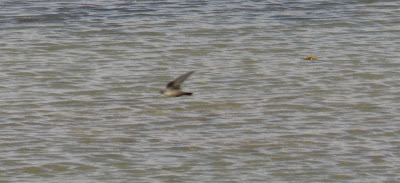On Friday afternoon, I went to the waste water site. This was the first visit for nearly two weeks but the weather was again dusty and visibilty was poor. The birding wasn't too good either.
The 16 common teal had become the 9 common teal.
The passerines had become mostly limited to common chiffchaff, Iberian chiffchaff, sardinian warbler and Sudanese golden sparrow. These are not bad birds for someone first arriving in Mauritania but are the bare mininum I have come to expect at this site in winter.
Sudanese golden sparrow
There have been three or more kestrel on the site for a few weeks now. They were still there.
common kestrel
There were also three different marsh harrier there at various times though I believe one of them, at least, moved on during the session. I doubt any of them will stay as long as the kestrel. There is no history of long staying marsh harrier at the site. Though I could be proved wrong in my prediction.
marsh harrier
little stint
I spent some time with the bird on the left above. It appears flatter, squatter than the more obvious little stint on the right. It has a slightly longer bill. The black lore is almost broken by a paler area. The tail looks attentuated. The breast band looks quite dense. The mantle has dark elements. However I am told it is still a little stint.
Having never seen a Baird's sandpiper, which I was considering, I found working out of a book and without practical experience to be tricky. It would appear a real Baird's sandpiper must have shorter legs and an even more attentuated tail with more obvious primary extention beyond the tail to be worth consideration. You live and learn.
ruff
All the ruff were obvious ruff. This time I spent no time considering the couple of potential American vagrants with similarities.
On Saturday morning, I teamed up with Mohamed Vall. We had a very successful day.
First we went to the fishing port area. At the waste dump, there were many white wagtail and a single yellow wagtail as well as several cattle egret. However, the range of plovers made for the most interest.
I had previously believed all Kittlitz's plover left Nouakchott in winter. However, an adult and the juvenile below were seen.
Kittlitz's plover
My new hypothesis is the vast majority migrate the short distance south but if there is some late breeding than the family is obliged to stay on. This looks like a case of late breeding. Either way the sightings were my first winter ones of Kittlitz's plover in two such seasons here.
barn swallow
Throughout the day, we were seeing barn swallow in the city. We didn't work out which way they were migrating.
cream-coloured courser
An unusual bird to see in the city, which was at the dump, was a cream-coloured courser. I have seen them visit dumps in villages before but not within an urban area.
Mediterranean gull (centre)
However, things turned round when we decided to walk north up the coast and straight through the fishing port and out the other side. The area directly in front of the fishing port had very little as usual.
Yet, the coastal strip just south of the port gave us good views of several terns. They were mostly common tern with the odd sandwich tern and Caspian tern. We spent quite some time trying to pick out any arctic tern without success.
common tern
The real success was just north of the fishing port, where we came across a great skua. It's white flashes on the upper wing and lower wing were noticed straightaway and made it a fairly easy identification even from distance. Somehow I managed a photo from 500 metres away with my bridge camera. This obviously large bird was terrorising a common tern at the time.
You can see why people say it gives the appearance of common buzzard.
great skua with a common tern
Great skua became species 293 on my Mauritanian list.
On the way back home, we stopped off at central lake. This is the one in the west of Tevragh Zeina where I recommend discretion when birding as it is close to embassies. Sometimes security prevents birding. Nevertheless, we birded the area of deepest water away from the road.
Very surprisingly, there were eight Eurasian crag martin foraging for insects over the water.
Eurasian crag martin
They are darker and certainly duskier than the African rock martin which is found in the Adrar region of the country. The latter bird does n't migrate either.
dark underwing coverts of Eurasian crag martin
Mohamed Vall and I took a long time trying to capture the dark underwing coverts in a picture. This is a good feature to help separate from African rock martin.
The distribution map in Birds of Western Africa shows Eurasian crag martin wintering down the Mauritanian coastal districts but this was my first sighting.
Within the space of an hour, my Mauritanian list had gone up again. This time to 294. It has been a long time since I have seen two new species in the city.
little grebe















No comments:
Post a Comment